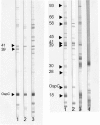Diagnosis of lyme borreliosis
- PMID: 16020686
- PMCID: PMC1195970
- DOI: 10.1128/CMR.18.3.484-509.2005
Diagnosis of lyme borreliosis
Abstract
A large amount of knowledge has been acquired since the original descriptions of Lyme borreliosis (LB) and of its causative agent, Borrelia burgdorferi sensu stricto. The complexity of the organism and the variations in the clinical manifestations of LB caused by the different B. burgdorferi sensu lato species were not then anticipated. Considerable improvement has been achieved in detection of B. burgdorferi sensu lato by culture, particularly of blood specimens during early stages of disease. Culturing plasma and increasing the volume of material cultured have accomplished this. Further improvements might be obtained if molecular methods are used for detection of growth in culture and if culture methods are automated. Unfortunately, culture is insensitive in extracutaneous manifestations of LB. PCR and culture have high sensitivity on skin samples of patients with EM whose diagnosis is based mostly on clinical recognition of the lesion. PCR on material obtained from extracutaneous sites is in general of low sensitivity, with the exception of synovial fluid. PCR on synovial fluid has shown a sensitivity of up to >90% (when using four different primer sets) in patients with untreated or partially treated Lyme arthritis, making it a helpful confirmatory test in these patients. Currently, the best use of PCR is for confirmation of the clinical diagnosis of suspected Lyme arthritis in patients who are IgG immunoblot positive. PCR should not be used as the sole laboratory modality to support a clinical diagnosis of extracutaneous LB. PCR positivity in seronegative patients suspected of having late manifestations of LB most likely represents a false-positive result. Because of difficulties in direct methods of detection, laboratory tests currently in use are mainly those detecting antibodies to B. burgdorferi sensu lato. Tests used to detect antibodies to B. burgdorferi sensu lato have evolved from the initial formats as more knowledge on the immunodominant antigens has been collected. The recommendation for two-tier testing was an attempt to standardize testing and improve specificity in the United States. First-tier assays using whole-cell sonicates of B. burgdorferi sensu lato need to be standardized in terms of antigen composition and detection threshold of specific immunoglobulin classes. The search for improved serologic tests has stimulated the development of recombinant protein antigens and the synthesis of specific peptides from immunodominant antigens. The use of these materials alone or in combination as the source of antigen in a single-tier immunoassay may someday replace the currently recommended two-tier testing strategy. Evaluation of these assays is currently being done, and there is evidence that certain of these antigens may be broadly cross-reactive with the B. burgdorferi sensu lato species causing LB in Europe.
Figures

References
-
- Aberer, E., C. Brunner, G. Suchanek, H. Klade, A. G. Barbour, G. Stanek, and H. Lassmann. 1989. Molecular mimicry and Lyme borreliosis: a shared antigenic determinant between Borrelia burgdorferi and human tissue. Ann. Neurol. 26:732-737. - PubMed
-
- Ackermann, R., J. Kabatzki, H. P. Boisten, A. C. Steere, R. L. Grodzicki, S. Hartung, and U. Runne. 1984. Spirochete etiology of erythema chronicum migrans disease. Dtsch. Med. Wochenschr. 109:92-97. - PubMed
-
- Agger, W. A., and K. L. Case. 1997. Clinical comparison of borreliacidal-antibody test with indirect immunofluorescence and enzyme-linked immunosorbent assays for diagnosis of Lyme disease. Mayo Clin. Proc. 72:510-514. - PubMed
Publication types
MeSH terms
Substances
LinkOut - more resources
Full Text Sources
Other Literature Sources
Medical

